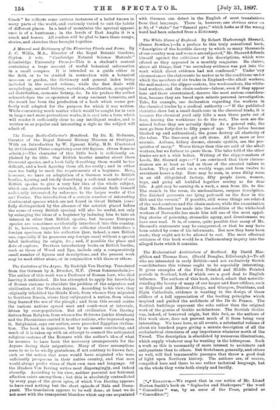The Ecclesiastical Architecture of Scotland. By David Mac- gibbon and
Thomas Ross. (David Douglas, Edinburgh.)—To all who are interested in early British—and not exclusively Scotch —architecture this volume ought to be especially interesting. It gives examples of the First Pointed aud Middle Pointed periods in Scotland, both of which owe a good deal to English influence. The authors of this book, indeed, admit that notwith- standing the beauty of many of our larger and finer edifices, such as Holyrood and Melrose Abbeys, and Glasgow, Dunblane, and Elgin Cathedrals, evidence is wanting in the design of these edifices of a full appreciation of the leading principles which inspired and guided the architects of the Ile de France. The Scottish buildings represent the echo rather than the original work of the genius of Gothic architecture. The Scottish Gothic was, indeed, of borrowed origin, but this fact, as the authors of this work show, does not prevent much of it from being very interesting. We have here, at all events, a substantial volume of about six hundred pages giving a minute description of all the ecclesiastical structures of any importance whatever north of the Tweed. The description is elucidated by numerous illustrations, which supply whatever may be wanting in the letterpress. Such a work as this is necessarily of more interest to architects and antiquarians than to others. But Scotchmen generally, and others as well, will find innumerable passages that throw a good deal of light upon Northern history. The authors are, of course, compelled here and there to use rather technical language, but on the whole they write both simply and lucidly.






































 Previous page
Previous page